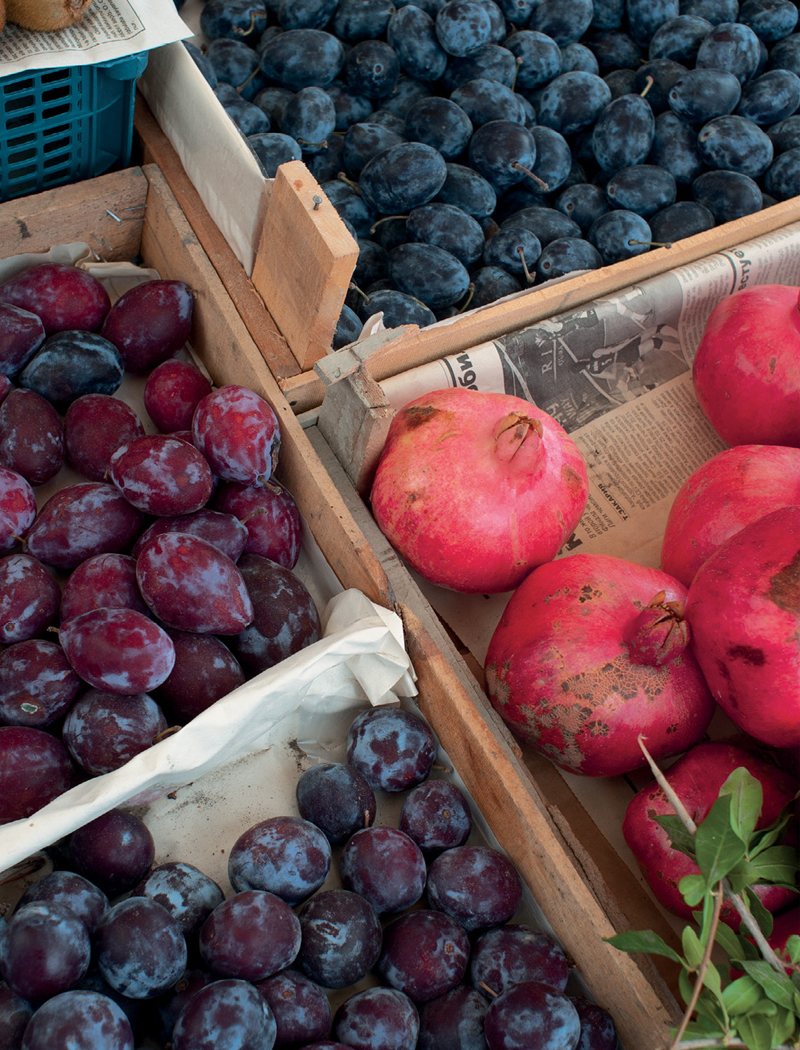

Sheki, Azerbaijan—Plums of many kinds grow in the Caucasus, as do both sweet and tart pomegranates.
If you have a pantry set up with jars of dried herbs and spices and a few other flavorings, you can transform all kinds of foods into extraordinary dishes. This is what creative cooks in the Persian culinary region have been doing for centuries.
A few simple flavorings such as Mint Oil (see recipe) and Saffron Water (see recipe) can add a special touch to many dishes, not just those from the Persian repertoire. And there are also several recipes for spice blends and flavored salts here, which are all easy, so you can just put them together when you need them or make them ahead.
The region is rich in versatile sauces and condiments of all kinds, from Walnut Sauce (see recipe) and Sour Plum Sauce (see recipe) to Tart-Sweet Apricot and Raisin Relish (see recipe). Some are eaten fresh, while a few, notably the red and green Georgian pastes called ajika (see recipes here and here), can be made in large batches to be stored in your pantry. You’ll find other pantry-treasures in the fruits chapter.
I now use mint oil to brighten all kinds of non-Persian dishes: lentil soups, vegetable soups and stews, and more. You can also drizzle it on salads or sliced cucumbers or chopped tomatoes, or add a swirl of it to lightly salted thick yogurt, to make a sauce for vegetables or grilled meats.
Dried mint is intense, and it keeps its flavor well. In the cuisines of the region, it’s not a second-best version of the fresh herb but a precious ingredient in its own right.
Makes about ¼ cup
¼ cup sunflower oil, extra-virgin olive oil, or butter-ghee
¼ cup dried mint
Place a small heavy saucepan over medium heat. When it is hot, add the oil or ghee and swirl to coat the pan, then toss in the dried mint, stir, and remove from the heat. Use immediately. Leftovers can be stored in a glass jar in the refrigerator but will lose aroma and flavor over time.
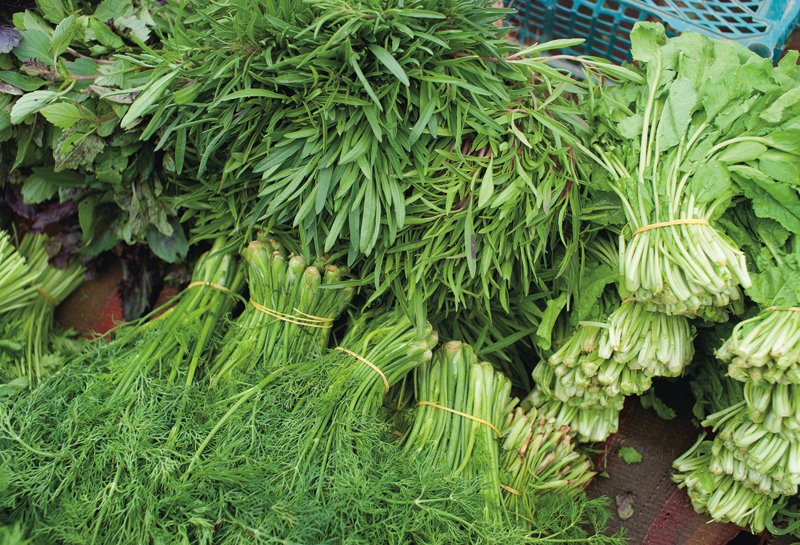
Yerevan, Armenia—Herbs and greens are plentiful from early spring until late autumn in markets all over the Persian world.
The dried herbs and spices listed below keep well stored in well-sealed containers in a cool place, and almost all are found in larger grocery stores. The exceptions, marked with an asterisk, are available in Persian, Arab, or Turkish grocery stores, or by mail order. Blue fenugreek is more difficult to get, so all the recipes include an alternative. For more information about any unfamiliar ingredients listed here, see Glossary.
Mint
Dill
Basil
Parsley
Saffron threads
Dried marigold petals
Dried rose petals
Blue fenugreek*
Powdered dried fenugreek leaves*
Summer savory
Coriander seeds (whole and ground)
Ground cumin
Ground cassia (cinnamon)
Cardamom (whole seeds and ground)
Turmeric
Ground cloves
Ground sumac
Ground allspice
Nigella seeds*
Black peppercorns
Ground fenugreek
Powdered dried red chiles or cayenne
Sunflower oil (the most common cooking oil in the Persian culinary region; you can use a light-tasting extra-virgin olive oil instead)
Pomegranate molasses*
Dried limes*
Rose water
Dried apricots
Sour plums*
Dried barberries*
Tamarind pulp*
Tart fruit leather (homemade—see recipe—or store-bought*)
Verjuice or wine vinegar
Walnuts (store in the refrigerator)
Pistachios (store in the refrigerator)
Sesame seeds (store in the refrigerator)
Dried orange peel*
Kashk (fermented whey) in dried balls*
Small plate, clockwise from top: Saffron water, a dried red cayenne chile, sumac powder, a branch of rose hips.
Small blue bowl: Dried mint leaves.
Ivory bowl: Mint oil.
Large plate, clockwise from top: Turmeric powder, a spoon of saffron water, and, with it on the white plate, coriander seeds and dried marigold petals; cumin seeds; fenugreek seeds, dried fenugreek leaves and stems, and a bay leaf (in the small bowl); saffron threads; Svanetian Salt (see recipe; in the tiny bowl); tamarind pulp; and dried limes.
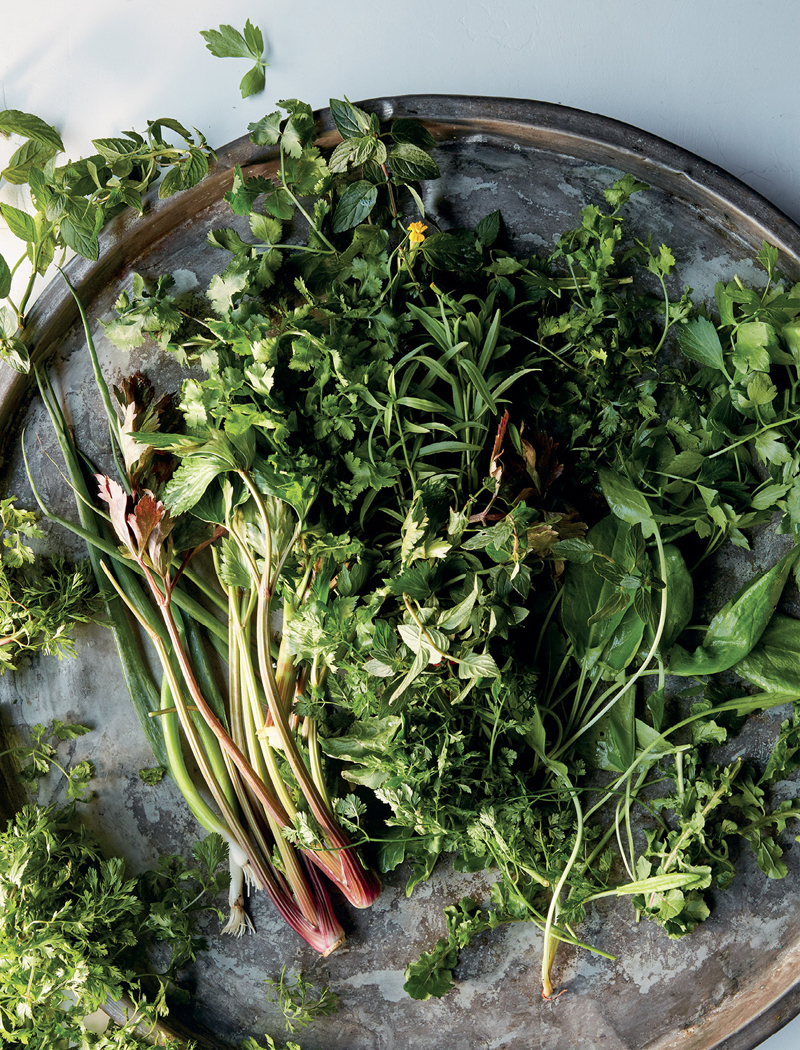
Fresh herbs are a constant at many meals throughout the Persian culinary world. They’re put out in generous quantities on a plate, perhaps supplemented by pickled turnip or pickled peppers (especially in wintertime) and a little fresh cheese. The name for this herb plate in Persian is sabzi khordan, which literally means “eating greens.”
In summer, it’s easy to find fresh tarragon, chervil, parsley, watercress, chives, basil, mint, dill, and coriander. But these days large grocery stores are doing a good job of bringing in herbs even in the winter.
A list of the possibilities is below. There may be herbs you don’t love—just use one or two of those you do like; you don’t have to make it a huge affair. Wash the herbs well, trim off the coarsest stems, and serve as large sprigs. You can also put out radishes, chopped or whole, or pickles of various kinds—whatever you feel will give fresh crunch and flavor to the meal. Persian-style pickles (called torshi in Persian) are available in Persian, Turkish, and Arab groceries, and so are whole pickled peppers and pickled garlic. If you have a little fresh cheese or feta, you can serve that too, as another taste option. (Any leftover herbs can be stored in the refrigerator, sealed in ziplock bags.)
In Kurdistan, where people use pieces of supple flatbread as eating utensils, they’ll often put a fresh herb sprig or a scallion on the bread before using it to scoop up, say, some bean stew or simmered chicken. The combining of fresh with cooked, of crisp with soft, is a sensual, satisfying way to eat. And it gives diners the freedom to shape each mouthful as they wish.
One or more: basil, coriander, mint, summer savory, parsley, scallions (halved lengthwise if large), fenugreek leaves, tarragon, watercress, dill, arugula, chervil, chives, and sorrel
Radishes, cherry tomatoes or sliced tomatoes, sliced peeled cucumbers, pickles, fresh cheese, and/or walnuts
Put the ingredients of your choice out on a plate or in a wide shallow bowl to accompany any noontime or evening meal. I like to include fresh herbs in my breakfast too, but that’s not traditional.

East of Mashad, Iran—On our way back from our saffron hunt, we stopped to chat with one of the older villagers here. He told us that the villagers were rug weavers, but sanctions had made dyes too expensive, and they had given up weaving.
I arrived in Mashad, in the far northeast of Iran, in late October. I’d read that the saffron harvest was in late October and November and I was hoping to see saffron crocuses, as the area around Mashad is Iran’s primary saffron growing region. With fingers crossed, I headed out of town on the hunt. I was with Hamid, the man who had arranged my visa. Though he’d grown up in Mashad, he knew nothing about saffron production, and he too was interested to find out more.
Hamid had been told that there were villages near Tus (birthplace and burial place of the revered Persian poet Ferdowsi) that are known for their saffron harvest. We drove past Tus, passing a small elegant stone tower built by the Mongols nearly eight hundred years ago, and out into a spare brown landscape. I was looking for fields of pale purple, or for signs of green leaves, but there were just bare fields edged with tree-lined water channels. We stopped at a baked earth–colored village to ask directions. A group of men and children was busy resealing the flat roof of their house in preparation for the rain and snow of winter.
They shook their heads: We were too early. There would be no flowers for another five or six days. They suggested that we head farther south, where the harvest always starts sooner.
We drove on, taking a road that parallels the Afghan border some fifty miles to the east. The countryside was vast and open, rolling green hills and sheep pastures in all directions, broken up by a few red-brown rocky outcrops. Small villages of stone and brick occasionally appeared, nestled into hillsides far from the road. I could imagine the Mongols sweeping in from the east, and later Tamerlane with his army, bent on conquest and destruction, with no trees or fences to get in their way.
After a while, we came to a scenic village and stopped to ask once again about saffron. “Oh yes, I just picked mine, but if you go over to that red house,” said the man we asked, “there should be flowers nearby.” There was no greenery visible, no color at all, at first glance. But when I looked more closely at the bare dirt in the small field, I could see, here and there, a tender beautiful purple bloom, and in the center of each, sticking up taller than the petals, three distinctive deep-orange stigmas.
Aha! The holy grail in all its fragility and loveliness. Seeking out and admiring flowers one by one, rather than finding fields full of them, was an unexpected end to my quest. It also felt very right that the precious saffron should be elusive.
The owner appeared. We explained that we were on the hunt for saffron. He told us that saffron needs cold weather to bloom and that the bulbs will yield a crop for seven years. Harvest is first thing in the morning, but some farmers also come by to pick flowers again in late afternoon, as he was doing.
The flowers sell for the equivalent of five dollars per kilo and buyers employ village women to pluck the stigmas. They accumulate slowly, three by three, as the pluckers work. No wonder saffron is expensive.
Why bother? I used to wonder. The answer is culinary and cultural. Even in small quantities, saffron gives fragrance and flavor to rice and other dishes. And saffron is also a sign of generosity. All the effort and expense involved in saffron production means that adding saffron to a dish makes it special.
I also wonder why and how the passion for saffron first developed. Perhaps it goes back to the reverence for and worship of the sun in Zoroastrian and animist times (see Zoroaster’s Legacy). The golden tint of saffron perhaps became precious because of its association with the divine.
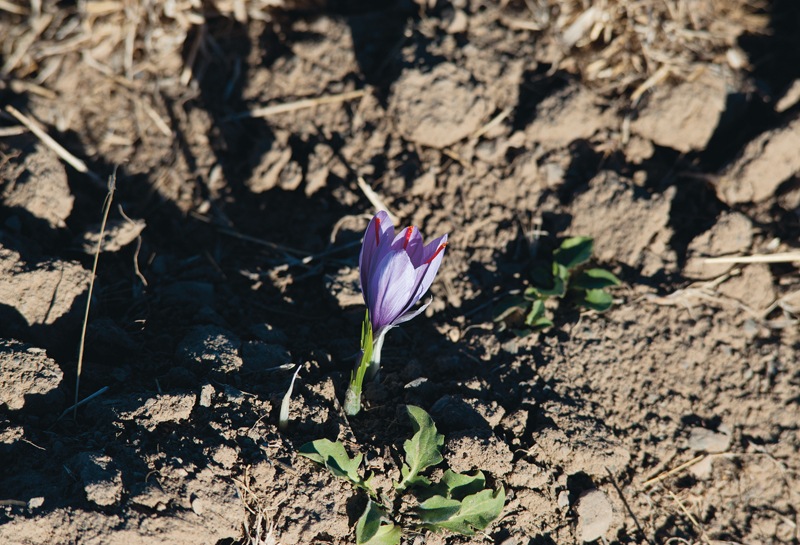
Northeastern Iran, southeast of Mashad—A saffron crocus in bloom with its three dark-orange stigmas.
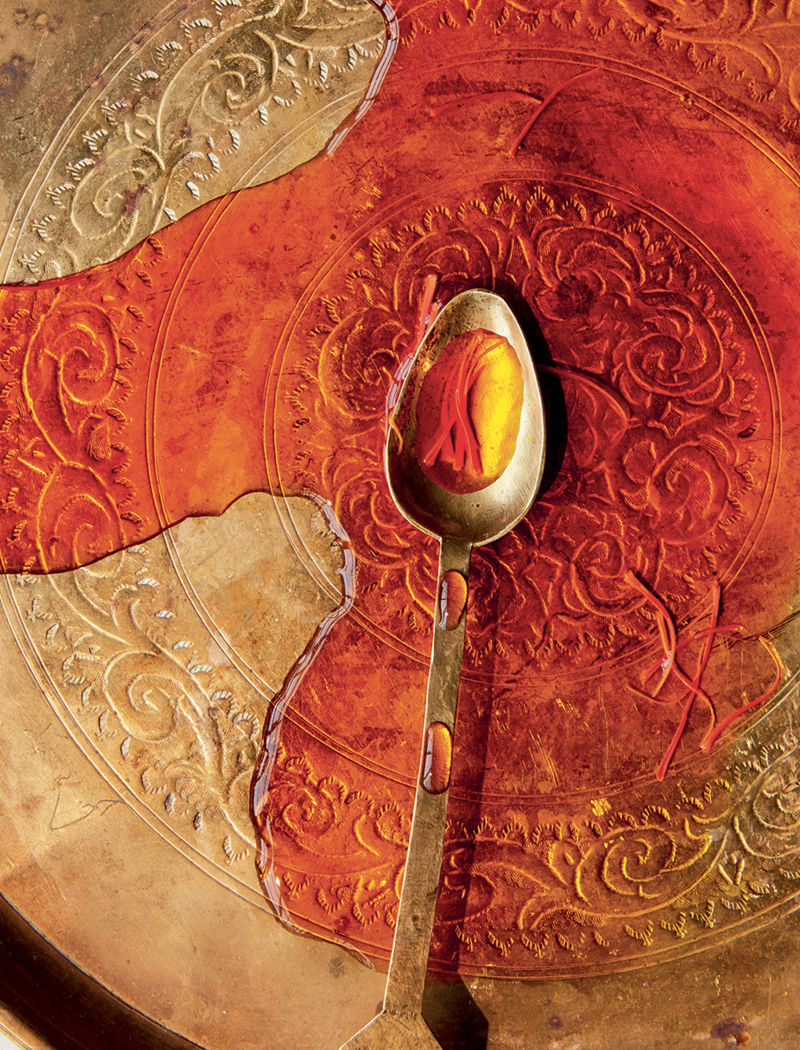
Once you find a good source of saffron—of saffron threads, as the stigmas are known—start using it. You can use them whole, but you get better color and aroma if you grind them to a powder. Just take a pinch and place it in a small mortar or bowl. Add a few grains of salt or sugar and use a pestle or the back of a spoon to grind the threads to a fine powder.
You can add saffron directly to a broth, but soaking it first in a little hot water is the best way to transform it into an effective flavoring and coloring, especially if you are using it to tint and flavor cooked rice. The proportions are roughly a generous pinch (¼ teaspoon) of saffron threads to ¼ cup hot water.
Pour the water over the threads or powder and stir. Transfer to a clean glass jar and let steep for at least 10 minutes, covered, before using it in a dish. As it sits, the color will deepen to a rich red-orange. Any leftover saffron water will keep in the refrigerator for a week or so, losing a little aroma over time.
One of the secrets of the Georgian kitchen is the basic spice blend called kmeli suneli in Georgian. I say “the” basic spice blend, but of course it varies among cooks, among regions, and according to the dish it is used for.
These days cooks in Georgia usually buy their kmeli suneli at the market, but many adjust the blend they buy, tweaking it to suit different dishes or their own tastes. Several versions of the spice blend are now available, imported from Georgia (see Glossary) and I hope that it will become more accessible in North America. I now most often use a blend from Kalustyan’s, in New York, but until recently I would make a batch of the basic powder, without the optional ingredients listed below, so I could have it on hand in a jar. I’d adjust it by adding in black pepper and other flavors if needed for a particular recipe.
Those of us who have no ready access to blue fenugreek (see Glossary) can substitute a mix of ground fenugreek seeds and powdered dried fenugreek leaves as set out below. And if you don’t have any dried marigold petals, simply omit them.
Makes about ½ cup (without the optional ingredients)
3 tablespoons ground blue fenugreek, or 2 tablespoons powdered dried fenugreek leaves plus 1 tablespoon ground fenugreek
2 tablespoons ground coriander
3 tablespoons powdered dried marigold or safflower petals (optional)
1 teaspoon powdered dried red chiles
2 teaspoons dried dill, or to taste
2 teaspoons dried basil, or to taste
2 teaspoons dried mint
1 teaspoon dried summer savory
1 teaspoon freshly ground black pepper
½ teaspoon ground celery seeds
Combine the fenugreek, coriander, dried flowers, if using, chiles, and optional spices and herbs as you like in a bowl. Store in a widemouthed glass jar.
Flavorings in Persian dishes are a subtle blend. Each recipe in this book gives specific ingredients, so there’s really no need to make up a separate spice blend, but you may want to experiment with this one. It’s an aromatic combination that enlivens soups and stews with warm flavors and that will give you an idea of the flavors of the Persian kitchen. Try it in a bean dish, or use it as a rub for a roast.
Makes 1 heaping tablespoon
1 teaspoon dried rose petals (optional)
1 teaspoon ground cassia (cinnamon)
1 teaspoon ground cardamom
½ teaspoon grated nutmeg
½ teaspoon ground cumin
If using the rose petals, grind them to a powder. Add the other spices and mix together.
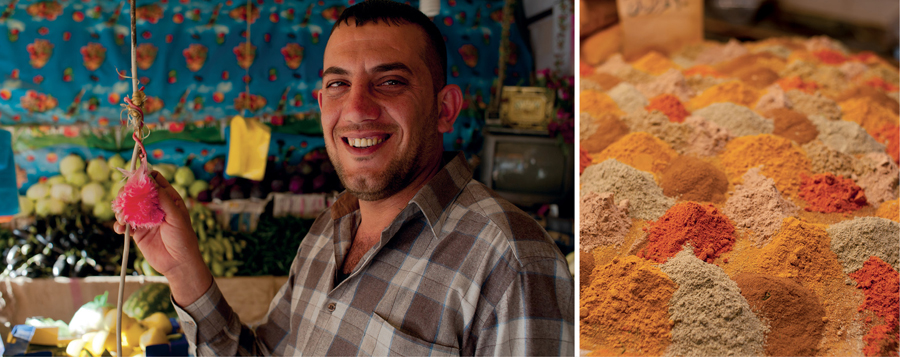
Left: Ainkawa, Kurdistan—A local grocer in this mostly Assyrian town. Ainkawa has grown to become a suburb of Arbil, the capital of Kurdistan.
Right: Isfahan, Iran—A display of ground spices (turmeric, powdered dried chile, cumin, and coriander) outside a spice shop in the bazaar.
In the spice section of Persian grocery stores, you’ll find packages labeled “golpar,” with the English translation given as angelica. It’s not European angelica, but a related spice with an appealing slightly bitter edge. It is used as a seasoning, either on its own or, as here, blended with an equal amount of salt. Sprinkle a pinch over cooked vegetables just before serving, or put some out on the table and invite your guests to help themselves.
Makes 2 tablespoons
1 tablespoon golpar powder
1 tablespoon sea salt
Mix together and store in a glass jar.

Massouleh, northern Iran—The spice often called angelica in Persian groceries in North America is called golpar in Persian, and is also known as Persian hogweed.
Photograph here
Svaneti is the highest, wildest, and most mountainous region of Georgia. It’s in the northwest, and until recently was cut off by snow for about six months of the year. Svan people have a reputation for toughness and a cuisine that is famous for its intense, distinctive flavors.
The basics of Svanetian salt, apart from salt, are pounded fresh garlic, and a blend of spices that includes dried red chile. The result is an aromatic coarse powder that keeps well in a cool place and is great to sprinkle on cooked and raw vegetables, from fried potatoes to sliced tomatoes to grilled corn, or to put out as a table condiment.
This recipe is adapted from instructions given to me by the Svanetian cousin-in-law of my friend Tamar. Traditionally all the ingredients except the salt would be home-dried herbs and garlic grown in the family garden.
Makes about 4 cups
About 10 fresh, firm garlic cloves (to yield ¼ cup coarsely chopped)
1 cup coarse salt
1 cup dried dill
1 cup ground coriander
¼ cup ground fenugreek
½ cup powdered dried fenugreek leaves
½ cup powdered dried marigold petals (optional)
2 heaping tablespoons ground caraway
3 tablespoons powdered dried red chiles or cayenne
Soak the garlic in cold water for 10 minutes. Peel the garlic cloves, smash with the flat side of a large knife or with a pestle, and set aside.
Place all the ingredients except the garlic in a food processor and process to a fine powder. Add the garlic and process for about a minute, until completely incorporated.
Transfer to two clean 1-pint glass jars and label clearly. Store away from heat and sun as you would any herb or spice.
Walnuts have an important place in many dishes from the Caucasus and Persia, sometimes subtle, sometimes in a starring role. In this versatile Georgian sauce, they are the main ingredient, ground in a food processor for ease (traditionally ground in a mortar), along with a little garlic and some balancing spices, and then extended, like a kind of nut mayonnaise, with water and a little vinegar.
If you have kmeli suneli (Georgian Spice Blend), you can use a generous tablespoon of that instead of the coriander, fenugreek, and flower petals.
Serve as a dipping sauce or drizzle over chopped cooked vegetables. It’s a great accompaniment to grilled chicken too. Flavors intensify as the sauce rests, so leftovers are a treat; they can be stored in the refrigerator for up to a week. The sauce thickens when chilled, so you may want to whisk in a little hot water to loosen it after you take it out of the fridge.
Makes about 1¾ cups
1 cup walnuts or walnut pieces
1 garlic clove
1 to 1½ teaspoons ground coriander, to taste (see headnote)
2 teaspoons ground blue fenugreek, or 2 teaspoons powdered dried fenugreek leaves plus ½ teaspoon ground fenugreek (see headnote)
1 teaspoon powdered dried marigold or safflower petals (see headnote), or substitute 1 tablespoon Saffron Water (see recipe)
½ teaspoon ground fennel seeds or dried dill (optional)
½ to 1 teaspoon cayenne, to taste
1 cup warm water, or as needed
1 tablespoon wine vinegar or cider vinegar, or to taste
1 teaspoon sea salt, or to taste
Use a food processor or a mortar and pestle to grind the walnuts and garlic to a fine, smooth paste. Transfer to a bowl and add the coriander, fenugreek, flower petals, if using (not the saffron water), optional fennel or dill, and cayenne. Add about 2 tablespoons of the warm water and the saffron water, if using, whisking until emulsified. Add the remaining water a little at a time, whisking until the sauce is smooth and quite liquid, like a cream soup. Stir in the vinegar. Add the salt, taste, and adjust the seasoning as you wish.
Photograph here
This delicious condiment from Azerbaijan is a favorite with me any time I am serving pilaf-style dishes. Tart dried apricots and seedless raisins are transformed by brief cooking with a little butter into a kind of confit or fruit relish with an intense tart-sweet edge. All it takes is a little time.
Serve with Turkey Kebabs (see recipe) or other grilled or roasted meat or with rice dishes. Although it was not part of the recipe I learned in Azerbaijan, I add a generous squeeze of lemon juice for an extra hit of tartness.
Serves 8
1 cup dried tart apricots, preferably organic and unsulfured, cut into quarters
1 cup dark or golden raisins
2 tablespoons butter
½ cup water
2 tablespoons sugar, or to taste
Pinch of sea salt
Juice of 1 lemon (optional)
Place the apricots and raisins in a bowl, add some water, swirl around to rinse them, and drain. Add water to cover and set aside to soak for 20 minutes, or until plumped.
Melt the butter in a heavy saucepan or skillet over medium heat. Drain the fruit, add to the pan, and cook over low heat, stirring occasionally, for 5 minutes. Add the water, sugar, and salt and bring to a boil, then reduce the heat and cook, partially covered, at a low simmer for 20 minutes. Check occasionally to make sure the mixture is not sticking, and add more water if necessary. Remove from the heat, taste, and add a little lemon juice if you like.
Transfer to a small bowl and serve.
All over the Persian culinary world, tart fruits play an important role in savory dishes. But in Georgia, there’s a brasher palate with a strikingly confident use of raw garlic and brilliant exploitation of tart fruits. Nothing exemplifies the Georgian way with flavor better than this knockout sauce.
The main ingredient is a sour plum called tkemali (see Glossary). Damson plums are the closest substitute, but they are usually available only for a short period in late summer and early fall. One option is to use unripe plums; another is to add lime or lemon juice, or verjuice. Or substitute other tart fruits, such as sour cherries or cornels (see Glossary). If you have Georgian spice blend, either homemade (see recipe) or store-bought (see Glossary), use 1 tablespoon of the blend instead of the fenugreek, coriander, and chiles.
Makes about 4 cups
2 pounds damson or other sour plums or unripe plums, halved, pitted, and coarsely chopped; or substitute other dried fruits (see headnote)
2 garlic cloves, minced (about 2 teaspoons)
1 teaspoon ground blue fenugreek, or 1 teaspoon powdered dried fenugreek leaves plus ½ teaspoon ground fenugreek (see headnote)
1 teaspoon ground coriander (see headnote)
½ teaspoon powdered dried red chiles (see headnote)
½ teaspoon dried summer savory (optional)
½ teaspoon ground celery seeds (optional)
½ teaspoon sea salt, or to taste
1 to 2 tablespoons fresh lime or lemon juice (optional)
Coarsely chopped fresh coriander
Place the plums in a heavy saucepan and add water to cover (about 1 cup). Bring to a boil, lower the heat, cover, and simmer until the plums have broken down into a pulp, about 15 minutes. Stir occasionally to make sure the plums are not sticking, and add a little more water if necessary.
Add the garlic and transfer to a food processor or to a bowl. Add the fenugreek, coriander, chiles, savory, celery seeds, if using, and salt and stir to mix thoroughly, or pulse several times. Taste for tartness—the sauce should be tart. Add the lime or lemon juice if needed.
If not serving immediately, transfer to four 1-cup sterile jars and refrigerate. The sauce will keep for 2 months.
To serve, put the sauce out in a small serving bowl and stir in some chopped fresh coriander (about 3 tablespoons per cup).
Photograph here
When pomegranates are available, this fresh-tasting uncooked sauce is a lovely way to dress up grilled fish or meat of any kind. For instructions on handling pomegranates, see Pomegranate Techniques.
Makes about 1 cup
Seeds from 2 pomegranates
¼ teaspoon sea salt, or to taste
About 2 tablespoons fresh lemon juice
½ cup chopped fresh coriander, or more to taste
Set aside 2 or 3 tablespoons of the pomegranate seeds for garnish. Place the remaining seeds in a large mortar or in a heavy bowl. Add the salt and lemon juice and use a pestle or the back of a wooden spoon to pound and press the seeds for a few minutes. Set aside to steep for 30 minutes or so; the salt will draw the juice out of the seeds.
Mix the pomegranate seeds and liquid with the coriander. Taste for salt and adjust if you wish. Transfer to a serving bowl and sprinkle on the reserved pomegranate seeds.
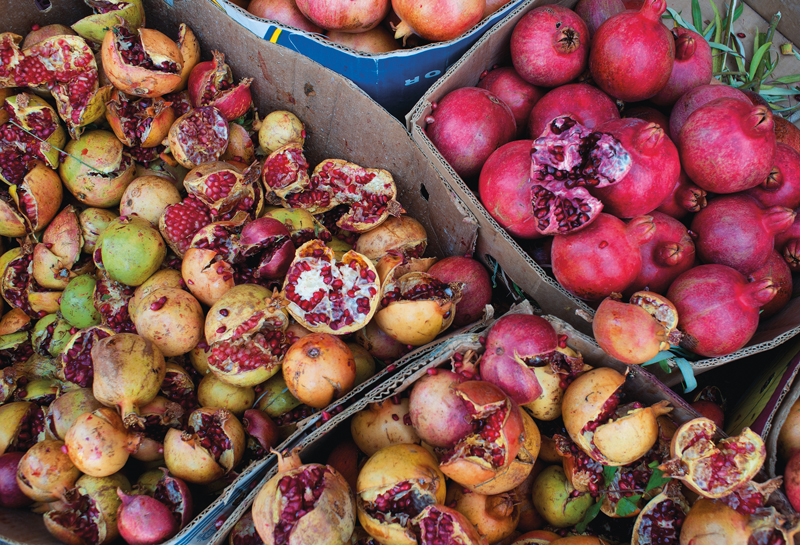
Pomegranates come in a variety of shades of red—from plum-wine to blush pink—and even in yellow-green. Their seeds are always red, but their flavor varies from sweet in the red fruits to tart in the yellow-tinted (and often smaller) varieties.

Yazd, Iran—Two boys on their way home from a trip to a bakery to buy bread for the family.
Zoroastrianism was the religion of the Persian Empire for about a thousand years, from the time of Darius until the Arab conquest in AD 651. There are still Zoroastrian temples, now maintained as museums, in Baku, the capital of Azerbaijan, and in Tbilisi, in Georgia. Some Persians who did not convert to Islam after the Arab conquest fled to the coast and then to India, where their descendants are known as Parsis. Others moved to more remote areas, especially to the desert city of Yazd, in central Iran, and to Kerman in the south.
But Zoroastrianism continued to have an impact in the greater Persian region, even on those who converted to other religions, and it still does to this day. Because it centers on the conflict between Good and Evil, and because the symbol of Ahura Mazda, the force of Good, is the sun, the spring equinox, which marks the return of the sun, is the most important festival for Zoroastrians. That celebration is called Nou-Roz (New Day). The spring equinox still marks the New Year in Iran, and Nou-Roz is celebrated by many in all parts of the Persian-influenced world, whether Muslim, Christian, or Zoroastrian.
Because green is the color of new life, food at Nou-Roz always involves herbs and greens (and often fish, another symbol of life). In Persian households, and in Azerbaijan, Georgia, Armenia, and Kurdistan, families sprout plates of wheat and other grains in the spring. The Christian cultures (in Georgia and Armenia) associate the sprouted grains with Easter, another celebration of rebirth, but the practice goes back to Zoroastrianism.
In Armenian households, people make a paste of sprouted wheat through long, slow cooking and serve it at Eastertime. A similar paste called samanu is made in Persian households and eaten on the first day of Nou-Roz.
One day long ago, at a small Persian grocery store in Toronto, the owners handed me a small spoon with a little paste on it. “Eat this samanu,” they said firmly. “It’s Nou-Roz today.” The paste was smooth, medium brown, slightly sweet, delicious, and unlike anything I’d ever tasted. Now, after immersing myself in Persian culinary traditions, I understand how special that food is.
Ajika, one of the glories of the Georgian table, is a chile paste that comes in many versions: red and green, chile-hot or milder, thick and dense or else more liquid like salsa. What all ajikas share is that they are salty, delicious uncooked condiments made of peppers, herbs, and aromatics. Each region has a different take (ajikas from Abkhazia and Samegrelo generally being the hottest), and of course people always prefer the one from their home region.
Red ajika is usually served with meat, but you can also mix it with yogurt as a flavoring or dressing for cooked or raw vegetables. Green ajika is for serving with beans or vegetables. It can also be used to flavor bazha (Walnut Sauce).
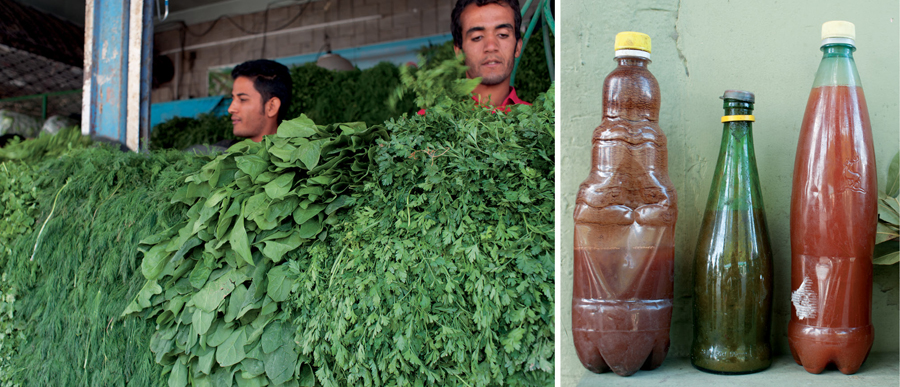
Left: Kerman, Iran—A wall of herbs and greens in the bazaar.
Right: Tbilisi, Georgia—Market vendors sell ajika in whatever containers they can find. Ajikas may be thick pourable sauces or dense pastes.
Green Ajika (see recipe) and Red Ajika (see recipe).
Photograph here
Although some Georgians have told me that green ajika should have no garlic in it, this one does, and it’s delicious. (The recipe is Mingrelian, from the Samegrelo region in western Georgia; it was given to me by the mother of a friend.) Smear a little on cooked corn on the cob, or dab some onto sliced cucumbers, or . . . You will find yourself making excuses to use it on all occasions, as I do.
The more finely ground the ajika is, the better. Georgians grind the ingredients in a meat grinder, putting them through the grinder over and over until they are smooth, but a food processor does a fine job. The paste is medium-hot, dense, and salty enough that it keeps well. It’s meant to be dabbed on as a condiment, not eaten in large dollops. You can also use it, mixed with a little oil, as a flavor paste for grilled chicken, or add a little to a vinaigrette to spice it up.
The recipe calls for dried red chiles that are seeded and soaked overnight to soften them (to shorten the time needed, you can instead simmer them in water for 30 minutes or so). And, once the paste has been ground, it rests for 6 to 10 hours (loosely covered and stirred occasionally). This pause lets some of the moisture evaporate and ensures that flavors are well blended.
If you want to make a larger quantity, I suggest that you make it in two batches and then combine them in a large bowl.
Makes 3 cups
2 ounces (about 150) dried red cayenne chiles
2 large bunches coriander
1 bunch flat-leaf parsley
1 bunch dill
1 bunch leaf celery (see Glossary)
1 bunch basil
¼ cup coriander seeds
¼ cup dill seeds
4 heads garlic, separated into cloves, peeled, and trimmed of any tough ends
2 medium leeks, white and tender green parts only, chopped and well washed, or 6 or 7 scallions, trimmed
¼ cup sea salt
Remove the seeds from the dried chiles: This is easiest if you work over a bowl, with another alongside for the cleaned chiles. One at a time, break each chile in half and empty the seeds into the first bowl. Break off and discard the stem if it is still there, and place the chile in the second bowl. When all of the chiles have been seeded, add warm water to cover, cover loosely, and set aside to soak and soften overnight. Alternatively, place in a saucepan with 2 inches of water, bring to a simmer, and simmer for 30 minutes, or until very soft.
Remove the coarsest stems from the herbs and set the herbs aside.
Dry-roast the coriander seeds in a small heavy skillet over medium heat, stirring regularly, until aromatic and lightly toasted, 3 to 4 minutes. Set aside. Dry-roast the dill seeds in the same way and set aside.
Drain the chiles and gently squeeze them dry. Place in a food processor and grind to a paste. Add the garlic and process to a paste. Add the leeks or scallions and process to a paste; use a spatula to scrape down the sides of the bowl. Process the herbs, adding them in batches (see Note), until the paste is smooth and thick and everything is finely ground.
Using a coffee or spice grinder or a mortar and pestle, grind the toasted coriander and dill seeds to a powder. Add them to the herb mixture, add the salt, and mix with a wooden spoon until thoroughly blended. Cover with a cotton cloth and let stand for 6 to 10 hours in a cool place; give the ajika a stir from time to time.
Transfer to clean dry glass jars and seal. The paste will keep for 3 months in the refrigerator.
Note: Grinding the ingredients in the food processor reduces their volume radically, but you may find that from time to time as you add ingredients to the processor, it seems overfull. Just remove some of the paste, process the new ingredients with the rest until blended in, and then add the rest of the paste back.
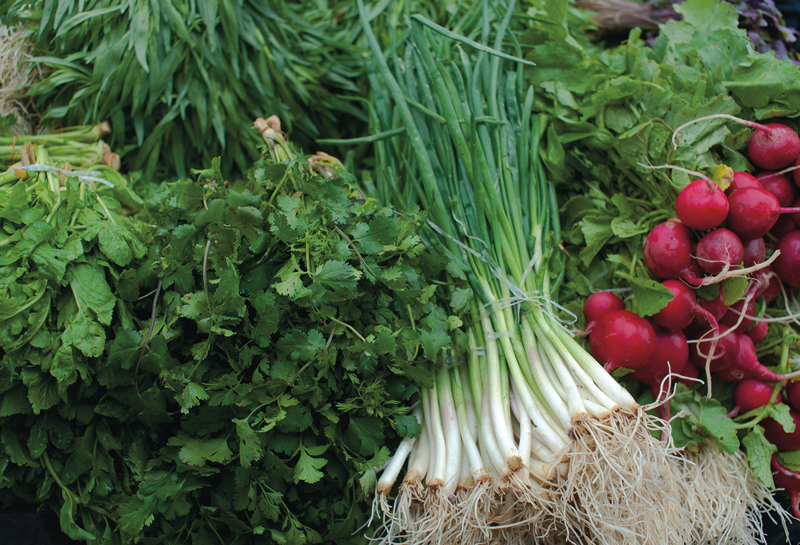
Telavi, eastern Georgia—Springtime freshness: coriander leaves, scallions, and radishes in front of a stack of tarragon in the Kakheti region of Georgia, famed for its wine.
Photograph here
Georgians make red ajika in the late summer or fall, when peppers are perfect and garlic still fresh, and they make large quantities—it’s a way of capturing summer and preserving its intensity for use in the winter months. I learned this recipe in Tbilisi from an artist and free spirit named Chuka, and I brought back a huge jar of it in my checked luggage. It soon became my go-to condiment.
A year later, my jar was empty and I was missing it badly. It was time to make some in my kitchen in Toronto. As we’d done in Tbilisi, I made a large batch. It’s always worthwhile, because once you have shopped for the ingredients, stripping out seeds and membranes from the peppers goes quickly (especially if you have a friend to help). The food processor does the rest of the work. And a large batch means you have extra to give to friends who love garlic, chile heat, and the taste of Georgia.
The chile paste is salty and intense. It needs to sit out, loosely covered, for 4 or 5 days before it goes into jars. I put it up in small (1- or 2-cup) jars, a good size for giving away.
Use red ajika as a spicy condiment with any meal. I love it in the morning with my fried egg, greens, and rice breakfast. And I put it out whenever I am serving meat dishes of any kind, from grilled kebabs to hearty stews. It’s an enlivening hit, and a crowd-pleaser.
Makes a generous 4 quarts
1 pound garlic, preferably organic
1 pound walnuts or walnut pieces
4 pounds red bell peppers, as ripe as possible
2 pounds fresh red cayenne chiles
¾ cup ground blue fenugreek, or ¾ cup powdered dried fenugreek leaves plus 3 tablespoons ground fenugreek
1 cup ground coriander
1 pound kosher salt
Put the garlic in water to soak for an hour.
Meanwhile, rinse the walnuts, peppers, and chiles and dry thoroughly. Cut the stems off the peppers and chiles. Cut lengthwise in half and remove and discard the seeds and ribs. Cut the peppers and chiles into approximately 1-inch pieces, discarding any imperfect bits, and set aside.
Drain and dry the garlic. Separate the heads into individual cloves and peel them. Set aside.
Check the walnuts and discard any flawed ones.
To grind the paste, use a food processor and work in batches. Start with some peppers and chiles, tossing in some walnuts and garlic from time to time. Transfer the paste to one or two large bowls as you go. Once all the ingredients are ground, add the fenugreek, coriander, and salt and stir in thoroughly. Cover the bowl(s) with a cotton cloth, and set aside at cool room temperature for 4 to 5 days. Stir several times to make sure the flavors blend.
Transfer the paste to dry sterilized jars and seal tightly. Store in a cool place; the paste will keep for 1 year. Once it has been opened, store in the refrigerator.
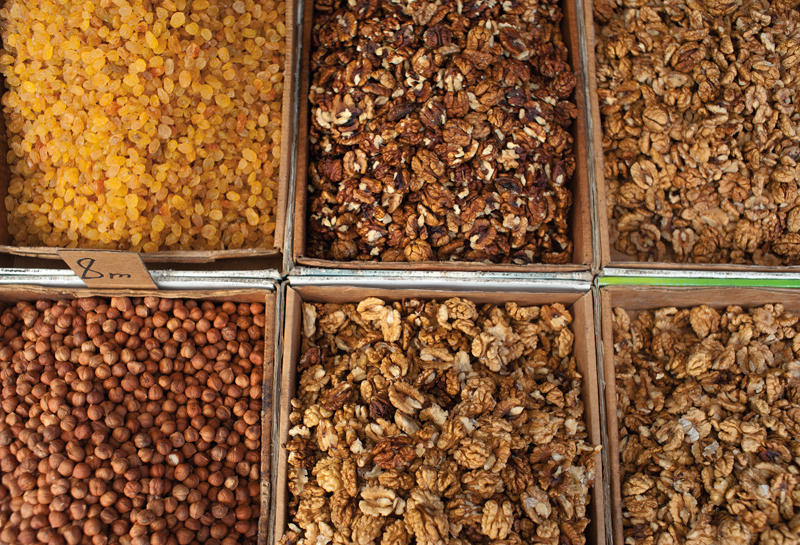
Sheki, Azerbaijan—Autumn brings newly harvested walnuts and hazelnuts and freshly dried fruit to the markets of the Persian world.